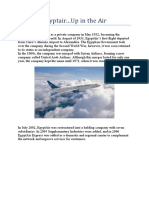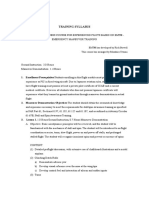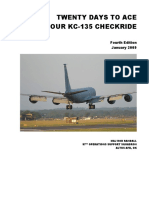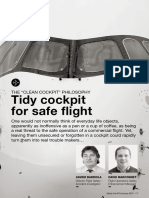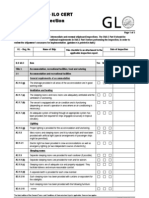100%(1)100% found this document useful (1 vote)
116 viewsTerps, Cfit, and Me
Terps, Cfit, and Me
Uploaded by
GooreshIFR
Copyright:
© All Rights Reserved
Available Formats
Download as PDF, TXT or read online from Scribd
Terps, Cfit, and Me
Terps, Cfit, and Me
Uploaded by
Gooresh100%(1)100% found this document useful (1 vote)
116 views4 pagesIFR
Original Title
Terps, Cfit, And Me
Copyright
© © All Rights Reserved
Available Formats
PDF, TXT or read online from Scribd
Share this document
Did you find this document useful?
Is this content inappropriate?
IFR
Copyright:
© All Rights Reserved
Available Formats
Download as PDF, TXT or read online from Scribd
Download as pdf or txt
100%(1)100% found this document useful (1 vote)
116 views4 pagesTerps, Cfit, and Me
Terps, Cfit, and Me
Uploaded by
GooreshIFR
Copyright:
© All Rights Reserved
Available Formats
Download as PDF, TXT or read online from Scribd
Download as pdf or txt
You are on page 1of 4
ON THE APPROACH
TERPS, CFIT And Me
The Korean Airlines B-747 controlled flight into terrain accident at Guam: DEJA VU.
10 IFR Refresher, June 1998
By Wally Roberts
ONCE AGAIN A PROFESSIONAL
airline flight crew has flown a perfectly
good jet airliner into the ground during
a non-precision instrument approach.
In August 1997, Korean Airlines Flight
801 (a B-747-300) collided with terrain
3.5 miles southwest of the Guam Airport.
I was invited by the National Trans-
portation Safety Board (NTSB) to tes-
tify at the public hearing of this acci-
dent, regarding the design of the ap-
proach procedure flown by KAL 801.
As a result of my participation, Ill
delve into the approach chart. At the
end of the article, Ill reflect on the
technical emotions triggered by this
event from an accident that occurred
in 1974. Ill also discuss my recommen-
dations to the NTSB and what you can
do to avoid a controlled flight into ter-
rain (CFIT) accident. First, Ill review
the circumstances of the accident.
The KAL crew was using the ILS
Runway 6L approach chart (page 11,
left). The glideslope had been notamd
inoperative (often informally referred
to as a localizer approach). Guam ATC
followed FAA practice by clearing
KAL 801 for the Runway 6L ILS ap-
proach, glideslope unusable.
Ill-fated flight path
Prior to clearing KAL 801 for the
approach, Guam ATC vectored the air-
craft at 2,600 feet to intercept the final
approach course between FLAKE in-
termediate fix and GUQQY FAF. At
this time the captain discussed with the
other two crewmembers that the
glideslope appeared to be working. As
a result, a constant descent of approxi-
mately 3 degrees was begun shortly
after localizer intercept. The descent
continued until the crew initiated a
missed approach, just prior to impact-
ing terrain over 600 feet high and 700
feet to the left of the Nimitz VOR.
The accident occurred at 0142 hours
local time. The reported weather at the
airport: 1,600 feet scattered, 2,500 feet
broken, 5,000 feet overcast, 7 miles vis-
ibility in rain, with scattered thunder-
storms in the area.
The crew had discussed all pertinent
aspects of the non-precision approach
profile, including the 1,440-foot step-
down altitude over the VOR, but no
attempt was made to level off at either
2,000 feet or 1,440 feet. Its apparent
the captain had concluded that spuri-
ous glideslope deviation indications con-
firmed a valid glideslope. I in no way
will attempt to justify the crews ac-
tion, other than to say I firmly believe
they werent intent on suicide.
Close look at Guam approach
The ILS 6L IAP is a no-brainer ILS
when the glideslope is working. With
the glideslope out, however, the VOR
stepdown fix becomes critically impor-
tant to get below 1,440 feet. In the case
of air carrier aircraft, this means split-
ting the captains and first officers nav
displays, which is contrary to sound
cockpit resource management and
makes display redundancy impossible.
Because of limited navigation facili-
ties on this remote island, the FAA
procedures designers were stuck with
making VOR (essential for missed ap-
proach) and DME (essential for non-
radar procedural entry and missed ap-
proach holding fix) a mandatory part
of this IAP. The FAA added a note
DME required, but there is no VOR
required note because the FAA con-
siders VOR to be aboard every IFR
aircraft. But, is that an intuitive con-
cept for all instrument-rated pilots?
Had there been an outer compass
locator (LOM), it would have been the
preferred tracking facility for the
missed approach procedure. This would
have negated the mandatory aspect of
VOR in this IAP, which would have trig-
gered a TERPs provision to chart both
1,440 and 560 as MDAs, without and
with stepdown fix. The charting of 1,440
as a conditional MDA, with its atten-
dant higher visibility minimums would
have been additional useful information
for this IAP. Perhaps having the 1,440
MDA, in addition to the 560 MDA,
could have been a CRM trigger point
for the KAL crew.
Redundancy and Safety Nets
At Guam, not only was the
glideslope out of service, the FAAs
minimum safe altitude warning sys-
tem (MSAW) was unknowingly in-
operative. Had the Guam MSAW
been working, there would have been
ample time for ATC to have made
the save with a low altitude alert.
Had the aircraft been equipped with
an enhanced ground proximity warn-
ing system (EGPWS) there would
have also been ample early warning
from that system.
These backup systems are not
crutches. The more redundancy
there is the bigger and stronger the
safety net.
CFIT Trend
Controlled flight into terrain
(CFIT) is the single biggest cause
of air carrier hull losses. Unless the
trend is abated, by early next cen-
tury experts predict there will be one
air carrier hull loss per week due to
CFIT worldwide.
The rate of CFIT accidents is low-
est in North America and varies
throughout the world to a horrific
rate in the mountainous areas of
South America. The rate of CFIT
accidents during non-precision ap-
proaches is five times that of preci-
sion approaches.
ON THE APPROACH
IFR Refresher, June 1998 11
(continued on next page)
At the hearing I testified that, had I
arrived at Guam under the circum-
stance that existed that night, I would
have requested the VOR/DME Run-
way 6L IAP (below right). This IAP
is less confusing than the non-precision
localizer IAP, and would permit me to
have full airline cockpit navaid display
redundancy. (Note the difference in the
profiles of the two IAPs, although the
controlling terrain in the vicinity of the
OM and VOR affects both procedures
TERPs-protected airspace in the same
manner.)
Lessons for all of us
The lessons of this CFIT accident ap-
ply to all of us. Put yourself in the cock-
pit at night. Add a long, fatiguing day,
with thunderstorms along the approach
course. Think of your own training and
proficiency when contemplating a dark
hole, bouncy air approach. What affect
will fatigue have upon you during such
REPRODUCED WITH PERMISSION JEPPESEN SANDERSON, INC., 1998. ALL RIGHTS RESERVED.
The ILS at Guam (left) is a no-brainer when the glideslope is working. Take away the glideslope and the VOR
stepdown fix becomes critically important to get below 1,440 feet. The VOR/DME procedure (right) is easier to
interpret during a dark and stormy night approach. The LOC procedure is unusual in that the DME counts
down to the final segment step-down fix, then counts up as you proceed to the missed approach point.
REPRODUCED WITH PERMISSION JEPPESEN SANDERSON, INC., 1998. ALL RIGHTS RESERVED.
conditions? For some specific guide-
lines, see page 15.
On my way home from the hearing,
I spoke with a senior pilot for a major
airline. He made the astute comment
that localizer approaches are unique
among non-precision IAPs: they often
have a useless, but wiggling glideslope
deviation indicatorwhich is like a
flame to the moth in the mind of a
pilot who flies 98 percent of his ap-
ON THE APPROACH
12 IFR Refresher, June 1998
TERPS, CFIT
(continued from page 11)
I recommended that an LOM be
added to the Guam ILS RWY 6L outer
marker. Further, a frequency-paired,
collocated ILS/DME should be added
to the instrument landing system. Most
transport category aircraft do not per-
mit separate tuning of the DME, so fre-
quency paired DME assumes an even
more important dimension for such air-
craft. ILS DME provides great infor-
mation for everyone. With it, you al-
ways have count-down DME to the
runway and the procedures designer
has the optimum flexibility in creating
non-precision localizer procedures.
Even with the full ILS, the ILS DME
adds the ability to mark the precision
FAF, and the DH-point, if the FAA
were to use these sensible options.
The FAA promised in the 1960s that
all FAA ILS installations would have
frequency-paired, collocated DME. In
spite of the promise of GPS, ILS is go-
ing to be the way of life at major air-
ports for many years yet. DME should
be part of the ILS equation.
ILS vs. LOC
Weve all been exposed to the pros
and cons of setting up an ILS approach
for reversion to localizer minimums in
the event of a sudden glideslope fail-
ure. Where a final segment stepdown
fix is involved, Ive always frowned on
this technique. I believe any localizer
IAP with one or more final segment
stepdown fix(es) should be charted
separate from the ILS IAP.
Where the ILS and localizer proce-
dures continue to be charted together,
there should be two titles: ILS and
LOC. When ATC knows the
glideslope is out of service, they would
clear you for the LOC procedure, thus
Roberts Recommendations on Guam and ILS vs. LOC Approaches
proaches over the years with an elec-
tronic glideslope.
Deja vu
In late 1974, I became intimately and
extensively involved in the investiga-
tion of TWA Flight 514; a B-727 that
collided with a hill northwest of Wash-
ington Dulles Airport. I was an 11-year
pilot for TWA at the time, was quali-
fied as captain on the B-727 and was
then chairman of the ALPA national
TERPs Committee.
Once it was generally known about
my involvement in that investigation, I
was the subject of never-ending views
and opinions from fellow TWA
crewmembers and so-called aviation
experts. The general consensus was
the crew of TWA 514 just didnt get
it or they wouldnt have flown into that
hill. (As the years go by, the expert
view of the crews conduct has soft-
ened.)
At the time of the accident, I never
felt as if I had the support of TWA man-
eliminating another point of possible
confusion or ambiguity.
The NTSB was also interested about
the role users play in commenting on
FAA design and development of indi-
vidual IAPs. The FAA TERPs expert
testified that the FAA coordinates all
new and amended IAPs with all
bonafide user groups. I pointed out this
coordination consists of the regulatory
textual document, which is nearly im-
possible for most pilots to decipher.
Besides, the form does not contain
nearly all the data which will appear on
the final approach chart. I believe the
FAA should circulate a proposed pro-
cedure in aeronautical chart form. In
addition to being circulated to the in-
sider user groups, the chart should be
available at the local airport and on an
FAA web site. With maximum pilot in-
put, the product can only be improved.
agementthat I was their worst night-
marea line pilot who knew more than
they did about TERPs. This attitude by
flight operations management inevita-
bly has a chilling effect, is close to the
subtle (and sometimes not so subtle)
implied intimidation to get the job done
or else.
Chilling effect
Im not suggesting that Korean Air-
lines has a repressive flight operations
management. In fact, I couldnt get a
reading on their attitude (one way or
another) at the hearing. What I am say-
ing is this attitude does exist within some,
if not many, flight operations manage-
ments throughout the world. Couple this
with air carrier training curriculums that
are all too often limited by economics,
and you gain insight into some of the
factors that eventually play in the chain
of events that lead to CFIT accidents.
Lowest common denominator
I bristle when I hear the inevitable
comments following an air carrier CFIT
crash that had the crew only been com-
petent, the accident wouldnt have oc-
curred. This comment is often followed
by some union bashing, e.g., if the pilot
unions wouldnt arbitrarily protect pi-
lots, the incompetents would be
weeded out.
The reality is the airline hires the pi-
lots and the airline trains and assesses
pilot proficiency. Pilot unions provide
the ability for pilots to collectively rep-
resent themselves to management on
issues pertaining to wages and work-
ing conditions. As far as I know, no pi-
lot union has ever successfully caused
a pilot to be returned to duty when the
company determined the pilot did not
meet minimum standards and the com-
pany made a proper case.
The phrase minimum standards in-
vokes emotions in everyone involved
in standards issues. When Im riding in
the back, why shouldnt my captain
be the best there is? Well, its simply
not possible to employ several thousand
pilots, and have them all be the best.
Then, there are the factors of stress,
fatigue, fear, work overload, etc. These
factors work to temporarily reduce the
abilities of both the sharp and not-so-
(continued on page 15)
IFR Refresher, June 1998 15
ON APPROACH
TERPS, CFIT
(continued from page 12)
sharp pilot. The sharp pilot begins from
higher ground, but that doesnt make
him immune from a fatal mistake un-
der sufficiently stressful conditions.
Wally Roberts is a retired airline
captain, former chairman of the
ALPA TERPs Committee and an ac-
tive CFII in San Clemente, CA. Visit
Wallys web site at www.terps.com
Avoiding CFIT
Be aware of the following risk
factors, present in many CFIT acci-
dents:
Airport near mountainous ter-
rain;
Limited or no ATC radar cover-
age (approaching an airport other
than primary airport where ATC ra-
dar located);
NDB or VOR approach;
Night black hole approach;
Limited runway/approach light-
ing.
A common element in all CFIT
accidents is the loss or a lack of situ-
ational awareness. Here are some
basic rules to avoid getting caught:
Maintain altitude and terrain
awareness. Know the minimum al-
titude for terrain/obstacle clearance
for the area in which youre operat-
ing. Plan an emergency safe altitude
you can climb to in the event you
get lost or confused.
When operating into an airport
with terrain in the vicinity, dont de-
scend unless youre on a published
route or segment of the approach.
Identify all navaids before fol-
lowing any course information.
Constantly cross-check your
position during the approach, even
on an ILS.
Remind yourself that youre
most vulnerable to CFIT at night, es-
pecially after a long day. Do what-
ever it takes to stay alert and moni-
tor the approach.
You might also like
- Airline2Sim A320 Cadet ProgramDocument21 pagesAirline2Sim A320 Cadet Program15 years agoNo ratings yet
- Airbus Safety Lib FLT Ops Gen Seq01Document11 pagesAirbus Safety Lib FLT Ops Gen Seq01Rohan ThakurNo ratings yet
- 541 Form Pel Pilot Application Caap 22012 Amend2Document2 pages541 Form Pel Pilot Application Caap 22012 Amend2Mark Deneb SaavedraNo ratings yet
- QRH ALX BTFG1 Rev1.3Document44 pagesQRH ALX BTFG1 Rev1.3Oguz Karan100% (1)
- Aire AcondicionadoDocument176 pagesAire AcondicionadoFabrizio Jesús67% (3)
- Dara Joy - Ritual of ProofDocument191 pagesDara Joy - Ritual of ProofJoandry Colás100% (2)
- Aggressive Manoevering: 03ADOBL01 April 2003Document3 pagesAggressive Manoevering: 03ADOBL01 April 2003Artem RassokhaNo ratings yet
- Air Crash Investigations - Inadvertent In-Flight Slat Deployment - The Near Crash of China Eastern Airlines Flight 583From EverandAir Crash Investigations - Inadvertent In-Flight Slat Deployment - The Near Crash of China Eastern Airlines Flight 583No ratings yet
- Air Pilots - Commercial Air Transport: Safety Briefing Note 12Document2 pagesAir Pilots - Commercial Air Transport: Safety Briefing Note 12Léa MercierNo ratings yet
- 1972 5 EngDocument15 pages1972 5 EngTateNo ratings yet
- 01-03 Go-Around ManeuverDocument31 pages01-03 Go-Around ManeuverwilmerNo ratings yet
- Takeoffs LandingsDocument2 pagesTakeoffs Landingsn58ydh6wbqNo ratings yet
- Everything Explained For The Professional Pilot Chapter 1 SummaryDocument2 pagesEverything Explained For The Professional Pilot Chapter 1 Summaryfelipeolarte0728No ratings yet
- Egyptair Up in The AirDocument10 pagesEgyptair Up in The AirdrenghalaNo ratings yet
- Flight Management SystemDocument10 pagesFlight Management SystemSIMAR SINGH CHAWLANo ratings yet
- Crosswind LandingsDocument12 pagesCrosswind LandingsNHAN TRINHNo ratings yet
- Turbukence4 - ENDocument29 pagesTurbukence4 - ENwilmerNo ratings yet
- PMDG 737 Ryanair Flows Checklists V2Document7 pagesPMDG 737 Ryanair Flows Checklists V2apayan1965No ratings yet
- MET For Flight PlanningDocument12 pagesMET For Flight Planningchhetribharat08No ratings yet
- Better Scanning Techniques Will Help Pilots Avoid Mid-Air CollisionsDocument4 pagesBetter Scanning Techniques Will Help Pilots Avoid Mid-Air Collisionsjunk5154No ratings yet
- Secondary StallsDocument3 pagesSecondary StallsMike Aguirre100% (1)
- Concise Guide To Safe FlyingDocument35 pagesConcise Guide To Safe Flyingairbuk doeingNo ratings yet
- COMMUNICATIONDocument13 pagesCOMMUNICATIONMichel Garandán PizzornoNo ratings yet
- Flight Safety Newsletter-Jan07 PDFDocument4 pagesFlight Safety Newsletter-Jan07 PDFTun Wai100% (1)
- AirmanshipDocument13 pagesAirmanshipPatrick Danielson100% (1)
- Volcanic AshDocument2 pagesVolcanic AshplunitaNo ratings yet
- Wingtip - Devices - BoeingDocument20 pagesWingtip - Devices - BoeingzaheerkaranjiaNo ratings yet
- Circling Approach 2 Eng 4Document1 pageCircling Approach 2 Eng 4porcotNo ratings yet
- VB Turbulence Penetration SpeedDocument1 pageVB Turbulence Penetration SpeedpedatiNo ratings yet
- ATPL Inst 6.3 PDFDocument8 pagesATPL Inst 6.3 PDFKoustubh VadalkarNo ratings yet
- Multi-Engine Training PacketDocument21 pagesMulti-Engine Training PackettekinNo ratings yet
- Stall&SpinDocument3 pagesStall&SpinMasahiro Utsumi100% (1)
- Communication Failure ProcedureDocument6 pagesCommunication Failure Procedureeak_ya5875No ratings yet
- 20 Days To Ace Your KC135 Checkride 4th EdDocument45 pages20 Days To Ace Your KC135 Checkride 4th EdRod SpenceNo ratings yet
- FCTM BriefingDocument4 pagesFCTM Briefingoic56401No ratings yet
- ERAU-Flight Operations Manual (PDF) - Course SidekickDocument305 pagesERAU-Flight Operations Manual (PDF) - Course SidekickCarlos Guillermo Calls FerroNo ratings yet
- The Golden Rules For PilotsDocument4 pagesThe Golden Rules For PilotsSE KotariNo ratings yet
- Pic Personal MinimumsDocument2 pagesPic Personal Minimumsapi-356550898No ratings yet
- Aic 41.3 PDFDocument39 pagesAic 41.3 PDFAndrew van WykNo ratings yet
- Non-Precision Approaches: Civil Aviation Advisory Publication October 2004Document20 pagesNon-Precision Approaches: Civil Aviation Advisory Publication October 2004Rajiv RimalNo ratings yet
- Africa Area: Iata In-Flight Broadcast ProcedureDocument7 pagesAfrica Area: Iata In-Flight Broadcast ProcedureJoel vitorNo ratings yet
- Levels of Automation - Advantages & DisdavantagesDocument22 pagesLevels of Automation - Advantages & DisdavantagesAnish Shakya100% (1)
- H 1 T P A: Andling Ense Eaflet WIN Iston EroplanesDocument8 pagesH 1 T P A: Andling Ense Eaflet WIN Iston Eroplanesroyalairmaroc737No ratings yet
- Aviation Weather 1Document219 pagesAviation Weather 1Moussa Kalifa N'GADJAGANo ratings yet
- AOPA - Thunderstorms and ATCDocument8 pagesAOPA - Thunderstorms and ATCEdward Rehr100% (2)
- Tab 17 Pilot SuppliesDocument64 pagesTab 17 Pilot SuppliesJacques Pierre Penent d'IzarnNo ratings yet
- B737 PBN GUIDANCE of RNAV APPDocument2 pagesB737 PBN GUIDANCE of RNAV APPKhairul Hasan100% (1)
- DA40 NG & DA40 Tundra Star Exterior Styling & Interior DesignDocument7 pagesDA40 NG & DA40 Tundra Star Exterior Styling & Interior DesignGeorgian DanielNo ratings yet
- Walk Around Check (Inspection)Document15 pagesWalk Around Check (Inspection)Andre CaemNo ratings yet
- Aircraft Performance PDFDocument13 pagesAircraft Performance PDFJoey MarksNo ratings yet
- Additional Study GuideDocument15 pagesAdditional Study GuideAmine ChabchoubNo ratings yet
- Tidy Cockpit For Safe FlightDocument7 pagesTidy Cockpit For Safe FlightPete AndreNo ratings yet
- Fly The Dog: Pilot Errors From A Pilot PerspectiveDocument13 pagesFly The Dog: Pilot Errors From A Pilot PerspectiveNur Sakinah IdrisNo ratings yet
- Proper Landing TechniqueDocument2 pagesProper Landing Techniqueanshit1No ratings yet
- 3-2009_G-THOFDocument64 pages3-2009_G-THOFJoey MarksNo ratings yet
- Commercial Pilot SyllabusDocument12 pagesCommercial Pilot SyllabusJadie Barringer IIINo ratings yet
- Pilot RefDocument3 pagesPilot Refvikash_kumar_thakurNo ratings yet
- The Fragile Voice Com LinkDocument3 pagesThe Fragile Voice Com LinkGooreshNo ratings yet
- A Course in Mathematical Statistics George G. Roussas p593 TDocument593 pagesA Course in Mathematical Statistics George G. Roussas p593 TGooreshNo ratings yet
- The Geometry of VisibilityDocument4 pagesThe Geometry of VisibilityGooreshNo ratings yet
- Notam Man Strikes Again!: Chart ReviewDocument3 pagesNotam Man Strikes Again!: Chart ReviewGooreshNo ratings yet
- Low Visibility OperationsDocument4 pagesLow Visibility OperationsGooresh100% (1)
- Hold, Then Reverse and GPS and Victor AirwaysDocument5 pagesHold, Then Reverse and GPS and Victor AirwaysGooreshNo ratings yet
- Graphic IFR Departure ProceduresDocument5 pagesGraphic IFR Departure ProceduresGooreshNo ratings yet
- Uncharted HoldingDocument1 pageUncharted HoldingGooreshNo ratings yet
- GPS Feeder RoutesDocument1 pageGPS Feeder RoutesGooreshNo ratings yet
- Intermatic DT27 Timer ManualDocument2 pagesIntermatic DT27 Timer ManualGooreshNo ratings yet
- Is This A NoPT ArrivalDocument1 pageIs This A NoPT ArrivalGooreshNo ratings yet
- HW 1Document1 pageHW 1GooreshNo ratings yet
- Vocabuilder - Traffic AccidentDocument2 pagesVocabuilder - Traffic AccidentWnhannan MohamadNo ratings yet
- Mallari Vs CADocument2 pagesMallari Vs CACrispina ReyneraNo ratings yet
- Abiad Vs AlbaydaDocument2 pagesAbiad Vs AlbaydaDwight Anthony YuNo ratings yet
- The Myth of Energy Transfer.Document5 pagesThe Myth of Energy Transfer.Ivan DuncanNo ratings yet
- IGC1 Revised True or False QUESTIONSDocument2 pagesIGC1 Revised True or False QUESTIONSInspire Kharian100% (1)
- Fighting Oil Spill On ShipDocument3 pagesFighting Oil Spill On ShipGiorgi KandelakiNo ratings yet
- FDTL FormDocument1 pageFDTL FormghobriniNo ratings yet
- Regular Verb PDFDocument21 pagesRegular Verb PDFnurin jazlina100% (1)
- ETS Hazard Identification - Slickline-Shorish1Document9 pagesETS Hazard Identification - Slickline-Shorish1Rahil QamerNo ratings yet
- Influence of Shell-Grate-Pulp Lifters On Sag Mill Performance - Sanjeeva - LatchireddiDocument12 pagesInfluence of Shell-Grate-Pulp Lifters On Sag Mill Performance - Sanjeeva - Latchireddi24628441malrayNo ratings yet
- Journal Reading: Pembimbing: Dr. Dr. Bambang Arianto, SP.BDocument19 pagesJournal Reading: Pembimbing: Dr. Dr. Bambang Arianto, SP.BwellystiantiNo ratings yet
- Concept of PlotDocument2 pagesConcept of PlotAsit Baran GhoshNo ratings yet
- Honda Fuel Cell Vehicle Response Guide ClarityDocument20 pagesHonda Fuel Cell Vehicle Response Guide ClarityForum PompieriiNo ratings yet
- Bournemouth Tram Crash 1908Document10 pagesBournemouth Tram Crash 1908droshkyNo ratings yet
- Epc Exported Palm CardsDocument2 pagesEpc Exported Palm Cardsandrew.zhang37No ratings yet
- Accident - Incident & Investigation Report (Bhs Inggris)Document3 pagesAccident - Incident & Investigation Report (Bhs Inggris)rubiNo ratings yet
- Hirarc Training IADC EqivalentDocument45 pagesHirarc Training IADC EqivalentNorman Ainomugisha100% (1)
- Defensive DrivingDocument61 pagesDefensive DrivingAi Heart Pink100% (1)
- Activity - Based Ehs Risk Assessment Form: Mactech Engineering & Trading Pte LTD Mactech Engineering & Trading Pte LTDDocument3 pagesActivity - Based Ehs Risk Assessment Form: Mactech Engineering & Trading Pte LTD Mactech Engineering & Trading Pte LTDRodhel Mark Julian PalermoNo ratings yet
- Tour Inspection Checklist F596eDocument5 pagesTour Inspection Checklist F596eNikos LevogiannisNo ratings yet
- Safety Awareness2Document23 pagesSafety Awareness2nasyaa1111No ratings yet
- Volvo s40 v40 Owners Manual 2001Document197 pagesVolvo s40 v40 Owners Manual 2001jgrav667No ratings yet
- Moral ValueDocument2 pagesMoral ValueHanis IzzatiNo ratings yet
- Hira-Exide-Pipe Rack Member, Angle, Sagrod Lifting by Rope PullyDocument1 pageHira-Exide-Pipe Rack Member, Angle, Sagrod Lifting by Rope Pullyshankar.murugesanNo ratings yet
- Carlton Mellick III - Apeshit PDFDocument196 pagesCarlton Mellick III - Apeshit PDFVacantMath100% (2)
- Diode AnimationDocument87 pagesDiode AnimationRamadhurai100% (2)
- Self Balancing Bicycle-AkshayDocument19 pagesSelf Balancing Bicycle-Akshayakshay67% (6)
- Guidelines For Developing EHS Plan For Building and Construction Sector - Abu DhabiDocument58 pagesGuidelines For Developing EHS Plan For Building and Construction Sector - Abu DhabiwritemeyouNo ratings yet














